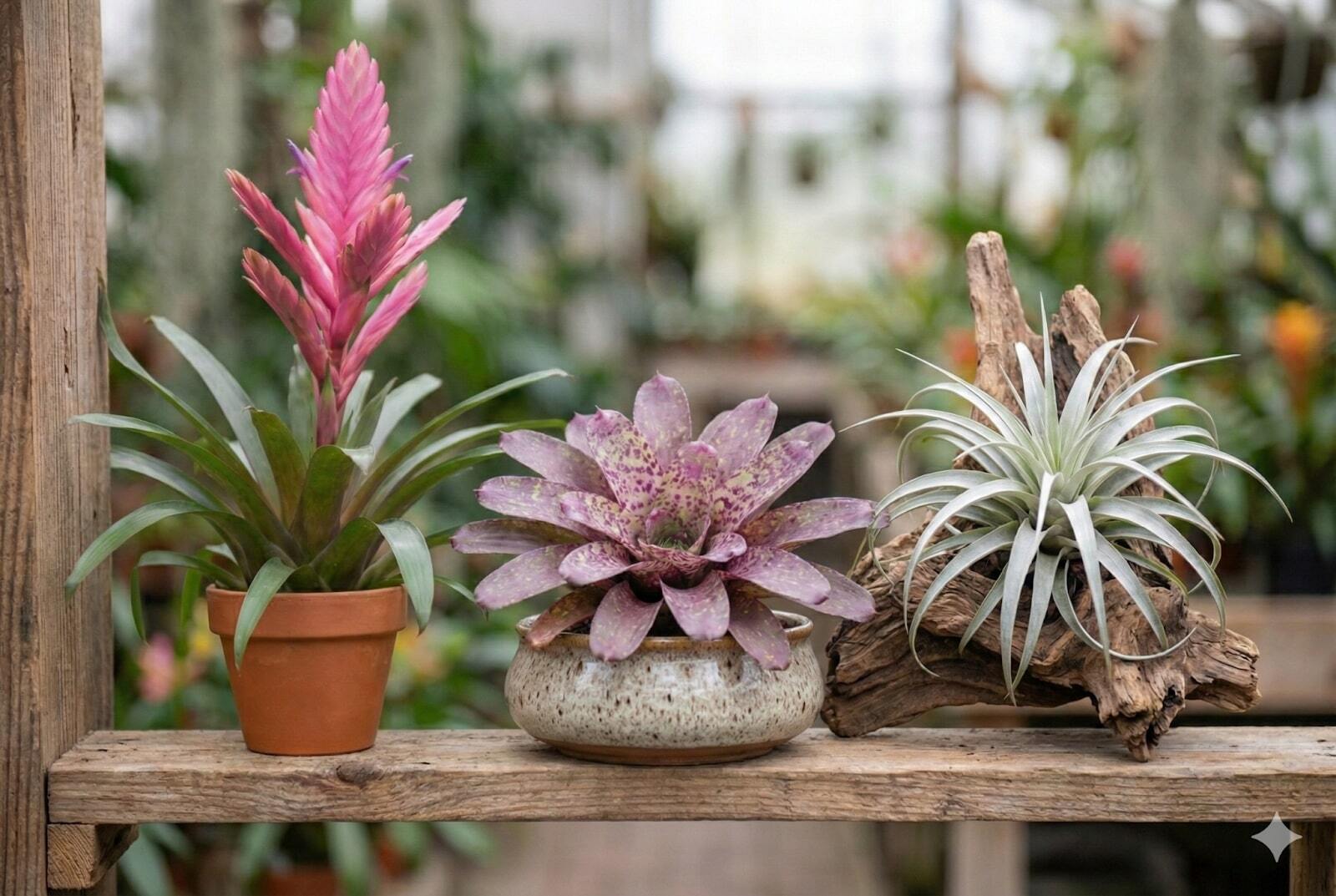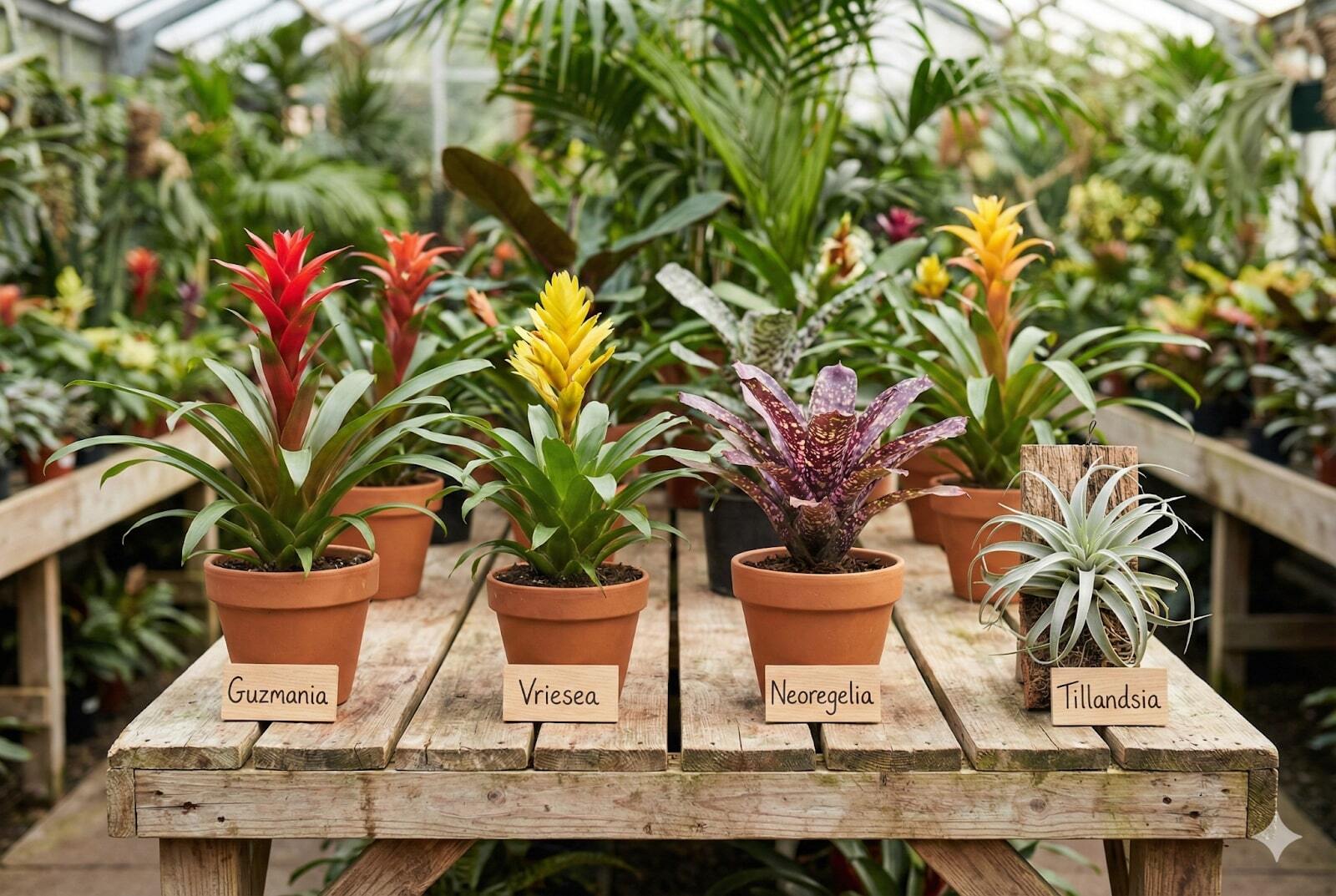Bromeliads Uncovered: The Complete Guide to Growing, Caring & Propagating These Tropical Beauties
Posted by Jason Wyrwicz on Nov 29th 2025

If you want a bold splash of tropical color in your home or office, bromeliads are a great choice. These striking plants bring bright bracts, lush leaves, and that fun “mini–rainforest” feel without high-maintenance care. Many varieties hold their color for months, giving you long-lasting beauty from a plant that hardly asks for anything in return.
Bromeliads come in all sorts of styles. Some grow in tight, glossy rosettes, while others send up tall, colorful blooms that look almost unreal. They sit nicely in small containers, brighten shelves, or stand on their own because they already look so unique. And since most types grow well as indoor bromeliads, you get that easy tropical feel all year long.
You can keep it simple with one standout plant or group a few varieties together in a larger planter for a bright, layered look. They thrive in well-drained pots, tolerate different light levels without fuss, and bring a warm, lively touch to any room.
If you’re new to these beauties or just want simple guidance on how to grow and care for bromeliads, this guide walks you through everything, including how to choose the right plant, water it properly, care for the blooms, and grow new pups.
Let’s uncover why bromeliads are some of the most exciting houseplants you can bring home.
What Are Bromeliads?

Bromeliads are a diverse family of tropical plants that are tougher than they look. Their most famous relative is the pineapple, which already hints at the sturdy nature of these plants. They’re known for bold colors, bright bracts, and leaf shapes that make them easy to spot.
Most bromeliads grow in a rosette form, where thick, strappy leaves curl inward to create a natural “cup.” This cup holds water in the wild, which helps the plant stay hydrated without relying much on its roots. Many species also grow as epiphytes, which means they attach themselves to trees or rocks instead of living in soil. Because of that, some varieties grow just as well mounted on wood as they do in a pot.
Even with their tropical look, they’re much easier to care for than most people expect. They come in many sizes, colors, and leaf patterns, so it’s simple to choose one that fits your space. Some stay compact, while others grow a bit taller and show off bright bracts that keep their color for months.
If you want a plant that looks unique, bromeliads are a great pick, and they look even better in a round bowl, a low square planter, or a long rectangular planter that lets their leaves spread out with ease.
Choosing the Right Bromeliad

Picking the right bromeliad is easy once you know what each type needs. These plants come in many looks and sizes, so you can match them with your light, space, and décor.
Here’s what to look for:
Match the plant to your light: Soft-leaf varieties do best in gentler light, while hard-leaf types handle brighter spots without trouble. When the light suits them, their colors stay rich, and their growth stays strong.
Think about size and placement: Some stay small enough for a shelf or desk, while larger ones work well in living areas where you want something bold. Knowing where you want to place your plant makes the choice much easier.
Check the leaves for health: Look for firm, even leaves with no browning or soft spots. A healthy bromeliad holds its form well and has a clean, open center cup.
Give the roots a quick look: The roots should be firm and light in color. Bromeliads don’t grow large root systems, but they should still look healthy and steady in the pot.
Pick a style that fits your space: Bright, colorful options like Guzmanias add instant warmth, while patterned varieties like Neoregelias bring more texture and interest. This gives you room to choose something that feels right for your home.
Care Essentials

Bromeliads are easy to care for once you know what they like. These simple tips can help keep them healthy and colorful all year long.
Light
Most bromeliads enjoy bright, indirect light. A spot near a sunny window works well as long as the sun isn’t hitting the leaves directly. If the light is too strong, the leaves can scorch. If it’s too low, the colors may fade, or the plant may slow down.
Temperature & Humidity
Bromeliads prefer a warm environment. They stay comfortable in temperatures between 60°F and 85°F. They also love a bit of moisture in the air, so if your home feels dry, you can:
- Mist the leaves lightly
- Place the pot on a tray with pebbles and water
- Group your plants together for a softer, humid feel
Soil & Containers
Good drainage is one of the most important things for bromeliads. They don’t enjoy wet or heavy soil, so choose a mix made for orchids or bromeliads that stays light, airy, and quick to drain.
Their roots stay small, so a shallow pot works well without overwhelming the plant. They will thrive in wide, round bowls or low, square planters, which give the leaves room to spread. Some varieties even grow well mounted on wood, much like they do in the wild, which gives you a fresh way to display them.
Watering
The center “cup” or “tank” formed by the leaves is where bromeliads naturally collect their water. Fill this cup with clean, fresh water and change it often so it stays clear. You can moisten the soil as well, but don’t let it stay wet. Let the mix dry out a little before watering again. If you can, use rainwater or distilled water to avoid mineral buildup on the leaves.
Fertilizing
Bromeliads don’t need much feeding. A light, diluted liquid fertilizer every few weeks during the growing season is enough. You can mist the leaves gently or apply the fertilizer to the soil. Avoid pouring fertilizer directly into the cup, as it can burn the plant.
Blooming, Propagation, and Pups

Bromeliads have a unique cycle that surprises many new plant owners. They bloom only once in their lifetime, and that bloom can last for months. After the bloom fades, the mother plant slowly starts to decline, but this is completely normal. It’s not a sign of bad care.
As the mother plant ages, she begins to grow “pups,” which are small baby plants that form at the base. These pups will carry on the cycle and grow into full bromeliads of their own.
Here’s how to handle them:
Wait until the pups are ready: Let each pup grow to about one-third the size of the mother plant. At that point, it’s strong enough to be separated.
Use clean tools: Gently remove the pup using a clean, sharp knife or scissors. Try to keep some roots attached, but don’t worry if they’re small; bromeliads don’t rely heavily on large root systems.
Plant in fresh mix: Place the pup in a shallow pot with airy, fast-draining soil. Keep it slightly moist while it settles in.
Give it gentle light: Bright, indirect light helps the young plant adjust and grow without stress.
One of the best things about bromeliads is how easy it is to grow your collection from these pups. With a little patience, you’ll have new plants to keep, share, or place in your favorite planters.
Styling & Placement Ideas

Bromeliads bring instant color and warmth to a room, so you can have fun placing them in different spots around your home. Their bright bracts and tidy growth make them easy to style, even if you’re new to decorating with plants.
Here are a few ideas to try:
Use one as a centerpiece: A single bromeliad adds a nice focal point on a coffee table, kitchen island, or entryway console. Its color does most of the work for you.
Create a small cluster: Mix two or three varieties in a wider planter for a fuller look. The mix of colors and leaf patterns gives you a lively, tropical feel without much effort.
Brighten shelves or side tables: Compact varieties fit nicely on bookshelves or small tables. They add a soft pop of color without taking up too much space.
Hang them for a fresh twist: Some bromeliads grow well mounted or placed in hanging planters, which brings their tropical look up to eye level. This works well near bright windows with indirect light.
Add color to shaded patios: Many bromeliads enjoy outdoor shade or soft morning sun. They’re great for bringing life to covered patios, porch corners, or garden beds that need a little lift.
Play around with different pots, too. Neutral planters make the colors stand out, while textured ones add another layer of interest. There’s no strict rule. If it looks good to you and fits your space, it’s a perfect match.
Common Problems & Fixes

Bromeliads are pretty easygoing, but every now and then they can act up a bit. Fortunately, most of the problems have simple fixes once you spot what’s going on.
Here are the issues you’re most likely to run into and how to sort them out:
Overwatering: Too much water can cause root or crown rot.
Fix: Let the soil dry out more between waterings and use a fast-draining mix.
Low humidity: Dry air can make leaf tips brown or curl.
Fix: Mist the plant lightly or place it near other houseplants to raise humidity.
Too little light: Colors may fade, and growth may slow down.
Fix: Move your bromeliad to a brighter spot with soft, indirect light.
Pests (mealybugs or scale): These tiny insects can hide on the leaves.
Fix: Wipe them off with a soft cloth or use a gentle insecticidal soap.
Mother plant fading: It’s normal for the main plant to decline after blooming.
Fix: Focus on the pups growing at the base as they’re the next generation.
If you want quick guidance at a glance, here’s a simple reference:
Most of these issues clear up fast once you adjust the water or light. Bromeliads are very forgiving, so small changes usually bring them back to full health.
In Summary

Bromeliads bring a bright, tropical touch to any space, and they stay surprisingly easy to care for once you learn their basics. With the right light, a little moisture, and a calm approach to watering, these plants stay happy for months. And when the mother plant finishes her cycle, the pups she leaves behind make it easy to grow your collection.
They’re colorful, low-maintenance, and full of personality, perfect for anyone who wants a standout plant that still fits easily into everyday care. We recommend starting with one bromeliad, allowing it to settle in, and enjoying the simple beauty it brings to your home or office. Before long, you might find yourself adding a few more and creating your own little tropical corner.
Bring home a bromeliad and let a touch of that rainforest charm brighten your day.
Frequently Asked Questions
Here are a few quick answers to common questions people ask about bromeliad care:
How often should I water my bromeliad?
Keep the center cup filled with fresh water and refresh it often. Lightly water the soil when it starts to feel dry, but don’t let it stay wet.
Will my bromeliad bloom again?
The main plant blooms once in its lifetime. After that, it slowly fades while growing pups at the base. Those pups will mature and bloom later.
Can I grow bromeliads outdoors?
Yes, you can. They do well in shaded patios or spots with soft morning sun. Just protect them from harsh afternoon light and cold drafts.
Are bromeliads safe for pets?
Most bromeliads are considered non-toxic to cats and dogs, but it’s still best to keep curious pets from chewing on the leaves.
How big do bromeliads get?
It depends on the type. Some stay small enough for a desk or shelf, while others can grow a foot or more across. Always check the variety so you know what to expect.



